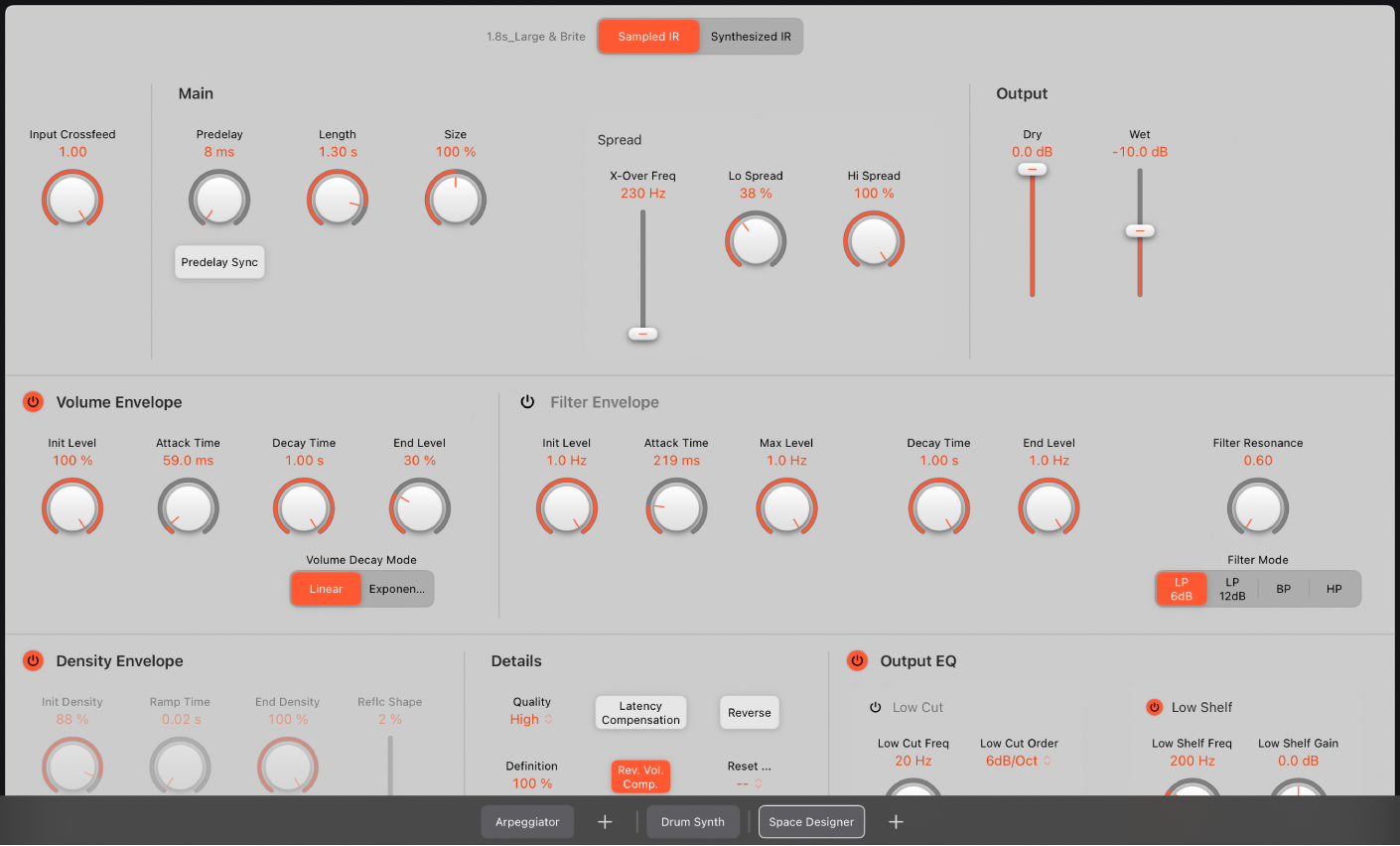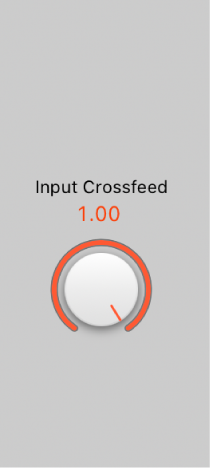Logic Pro User Guide for iPad
-
- What is Logic Pro?
- Working areas
- Work with function buttons
- Work with numeric values
- Undo and redo edits in Logic Pro for iPad
-
- Intro to tracks
- Create tracks
- Create tracks using drag and drop
- Choose the default region type for a software instrument track
- Select tracks
- Duplicate tracks
- Reorder tracks
- Rename tracks
- Change track icons
- Change track colors
- Use the tuner on an audio track
- Show the output track in the Tracks area
- Delete tracks
- Edit track parameters
- Start a Logic Pro subscription
- How to get help
-
- Intro to recording
-
- Before recording software instruments
- Record software instruments
- Record additional software instrument takes
- Record to multiple software instrument tracks
- Record multiple MIDI devices to multiple tracks
- Record software instruments and audio simultaneously
- Merge software instrument recordings
- Spot erase software instrument recordings
- Replace software instrument recordings
- Capture your most recent MIDI performance
- Route MIDI internally to software instrument tracks
- Record with Low Latency Monitoring mode
- Use the metronome
- Use the count-in
-
- Intro to arranging
-
- Intro to regions
- Select regions
- Cut, copy, and paste regions
- Move regions
- Remove gaps between regions
- Delay region playback
- Trim regions
- Loop regions
- Repeat regions
- Mute regions
- Split and join regions
- Stretch regions
- Separate a MIDI region by note pitch
- Bounce regions in place
- Change the gain of audio regions
- Create regions in the Tracks area
- Convert a MIDI region to a Session Player region or a pattern region
- Replace a MIDI region with a Session Player region in Logic Pro for iPad
- Rename regions
- Change the color of regions
- Delete regions
-
- Intro to chords
- Add and delete chords
- Select chords
- Cut, copy, and paste chords
- Move and resize chords
- Loop chords on the Chord track
- Color chords on the Chord track
- Edit chords
- Work with chord groups
- Use chord progressions
- Change the chord rhythm
- Choose which chords a Session Player region follows
- Analyze the key signature of a range of chords
- Create fades on audio regions
- Extract vocal and instrumental stems with Stem Splitter
- Access mixing functions using the Fader
-
- Intro to Step Sequencer
- Use Step Sequencer with Drum Machine Designer
- Record Step Sequencer patterns live
- Step record Step Sequencer patterns
- Load and save patterns
- Modify pattern playback
- Edit steps
- Edit rows
- Edit Step Sequencer pattern, row, and step settings in the inspector
- Customize Step Sequencer
-
- Intro to mixing
-
- Channel strip types
- Channel strip controls
- Peak level display and clipping
- Set channel strip volume
- Set channel strip input format
- Set the output for a channel strip
- Set channel strip pan position
- Mute and solo channel strips
- Reorder channel strips in the Mixer in Logic Pro for iPad
- Replace a patch on a channel strip using drag and drop
- Work with plug-ins in the Mixer
- Search for plug-ins in the Mixer in Logic Pro for iPad
-
- Effect plug-ins overview
-
- Instrument plug-ins overview
-
- ES2 overview
- Interface overview
-
- Modulation overview
- Use the Mod Pad
-
- Vector Envelope overview
- Use Vector Envelope points
- Use Vector Envelope solo and sustain points
- Set Vector Envelope segment times
- Vector Envelope XY pad controls
- Vector Envelope Actions menu
- Vector Envelope loop controls
- Vector Envelope point transition shapes
- Vector Envelope release phase behavior
- Use Vector Envelope time scaling
- Modulation source reference
- Via modulation source reference
-
- Sample Alchemy overview
- Interface overview
- Add source material
- Save a preset
- Edit mode
- Play modes
- Source overview
- Synthesis modes
- Granular controls
- Additive effects
- Additive effect controls
- Spectral effect
- Spectral effect controls
- Filter module
- Low, bandpass, and highpass filters
- Comb PM filter
- Downsampler filter
- FM filter
- Envelope generators
- Mod Matrix
- Modulation routing
- Motion mode
- Trim mode
- More menu
- Sampler
- Studio Piano
- Copyright
Use impulse responses in Logic Pro for iPad
Space Designer can use either recorded impulse response files or synthesized impulse responses. The Sampled IR and Synthesized IR buttons switch the impulse response mode.
Important: To convolve audio in real time, Space Designer must first calculate any parameter adjustments to the impulse response. This requires a moment or two following parameter edits.

Impulse response parameters
Use to load, save, or manipulate recorded or synthesized impulse response files. The chosen impulse response file determines what Space Designer uses to convolve with your audio signal.
Sampled IR button: Switch to Sampled IR mode. In this mode, an impulse response sample is loaded with the current preset or patch and used to generate reverberation. The name of the loaded IR sample is shown to the left.
Synthesized IR button: Turn on Synthesized IR mode. A new synthesized impulse response is generated, derived from the values of the Length, Envelope, Filter, EQ, and Spread parameters.
Input Crossfeed knob and field: Determine how Space Designer processes the stereo input signal.
Use Sampled IR mode
In Sampled IR mode, Space Designer loads and uses an impulse response recording of an acoustic environment. This is convolved with the incoming audio signal to place it in the acoustic space provided by the impulse response.

In Logic Pro, tap the Sampled IR button.
When you tap the Sampled IR button, the name of the loaded IR sample is shown to the left.
Tap a different Space Designer preset in the Browser to change the impulse response.
Use Synthesized IR mode
In Synthesized IR mode, Space Designer generates a synthesized impulse response based on the values of parameters such as Length, Filter, Spread and various envelope values.
Note: You can switch between a loaded impulse response sample and a synthesized impulse response without losing the settings of the other.

In Logic Pro, tap the Synthesized IR button.
Repeated taps of the Synthesized IR button randomly generate new impulse responses with slightly different reflection patterns. The current impulse response state is saved with the setting file, including parameter and other values that represent the IR reflection patterns and characteristics.
Note: Tapping the Synthesized IR button while you’re in Sampled IR mode switches to the synthesized impulse response stored with the setting.
Use the Space Designer Input Crossfeed knob
The Input Crossfeed knob works only in stereo channel configurations.

In Logic Pro, use the Input Crossfeed knob to determine how a stereo signal is processed.
At a value of 1.00 the signal is processed on both channels, retaining the stereo balance of the original signal.
At a value of 0.50 the signal is processed in mono.
At a value of 0.00 the signal is inverted, with processing for the right channel occurring on the left, and vice versa.
In-between positions result in a mixture of stereo to mono crossfeed signals.
Download this guide: PDF